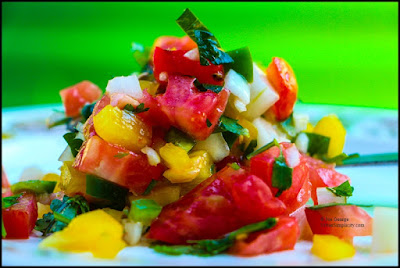Gazpacho (on a plate)
Gazpacho. Is it a soup or salad? Maybe both. Or maybe a sauce of sorts (salsa). It’s interesting, I think, that sauce, salad, and salary all share the same common root, sal, which is Latin for salt. A sauce was originally a form of salted liquid to season foods, and salting is what one did to their lettuce (and other vegetables) to bring out its natural flavors. And the English word salary is said to derive from sal because this is what slaves were often given in return for their back breaking work during Roman times. But I’m jumping ahead..
Like the rest of America, and the world no doubt, it has been hot, consistently hot this summer. I no longer work in a sweltering kitchen; the one in which I toil these days is an open kitchen. It gets warm but not hot. Yes, it is uncomfortable at times but not the...I hope I make it through this shift without passing out hot...that I was accustomed to. But for that my heart goes out to all my fellow culinarians who are working through those conditions in this hot summer.
With thus said, my house is not air conditioned. Not at all. Speaking with a neighbor recently I commented that I think I’m 1 of like 10 people in the city—ironically, the city in which air conditioning was invented—that didn’t have an air conditioner. He responded by saying I was also probably like 1 of 10 people who didn’t own a car. Neither of these are accurate, of course, but I thought it was funny.
Anyhow, the thought of cooking dinner in my sweltering home kitchen was less than appealing, so before I left the glassed-in air conditioned room which is the fancy grocery store in which I am currently employed, I bought a few things to make an easy dinner. Surveying the shelves that were overflowing with heirloom tomatoes and golden peppers, gazpacho came to mind. But I didn’t want soup, per se, but more of a chunky salad. And as I meandered the produce selection I thought about gazpacho, the recipe of course, but also it’s origin...like most foods it grew out of locality and possibly necessity. Use what you have to feed people.
Gazpacho is a recipe that has been around in various forms for a very long time, but the path to what we know it as today is likely convoluted. It’s said to have existed in Spain for more than a thousand years (possibly Moorish or Arab in origin), but prior to the fifteenth century it didn’t contain tomatoes and wasn’t red (tomatoes are a New World ingredient; they didn’t find their way into European cooking until the 1500’s). It most likely began as a vegetable, garlic, and herb soup that was thickened with breadcrumbs and ground almonds. Or possibly a chunky salad with bread in it to “stretch” the meal and utilize stale bread, not unlike the Italian panzanella or Middle Eastern fattoush I suppose. It’s truly an archaic recipe, a sort of edible archeological dig for food historians. Interestingly, the word soup is derived from the Middle English, sop, or sup, referring to a stale piece of bread onto which broth is poured to give a slight meal some substance. Today—because of the “gluten scare” and other reasons, I suppose—gazpacho is often made without bread. There are no hard and fast rules as to what gazpacho is or should be, but it’s often based on many of the same ingredients from its original versions: vegetables, garlic, vinegar, oil, and sometimes bread.
Tonight for dinner I made gazpacho which was more salad-like than it was a soup. It was delicious and took about 10 minutes to prepare. I ate it with large dollops of guacamole and Greek yogurt, and toasted slices of whole wheat bread and a glass of red wine. And as I sat eating I couldn’t think of abetter or more appropriate dinner to have on a sweltering July evening. Below is how I made this gazpacho salad (pictured above), and below that is a traditional recipe for gazpacho as a soup.
Gazpacho on a plate
Dice one or two large ripe tomatoes, a piece of cucumber, a small onion, a bell pepper, one or two jalapeno, a clove or two of garlic, parsley, and cilantro. Combine everything together in a bowl and add a quarter-cup of virgin olive oil and 2 or 3 tablespoons white wine vinegar. Season with kosher or sea salt and black pepper and mix together. Allow the flavors to mingle for about 5 minutes while you pour a glass a wine or slice some bread or set the table. Eat the salad straight from a bowl or transfer to a plate with other ingredients.
Gazpacho
Makes about 4 cups
2 cups diced tomatoes
1/2 cup diced red bell peppers
1/2 cup diced cucumbers
1/4 cup loosely packed fresh breadcrumbs
1/4 cup diced onion
1/4 cup virgin olive oil
2 tablespoons white wine vinegar
2 hot peppers
2 teaspoon minced garlic
1 teaspoon kosher salt
1 teaspoon black pepper
1/2 teaspoon basil
1/2 teaspoon oregano
Combine all of the ingredients in a blender and pulse until desired consistency. Let stand 10 minutes; served chilled or at room temperature. Optional garnishes include but are not limited to: diced raw onion, hard cooked egg, parsley, and olives.
Urban Simplicity


Comments